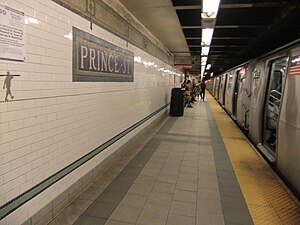Prince Street station
Prince Street | |||||||||||
|---|---|---|---|---|---|---|---|---|---|---|---|
 | |||||||||||
| Station statistics | |||||||||||
| Address | Prince Street & Broadway New York, NY 10012 | ||||||||||
| Borough | Manhattan | ||||||||||
| Locale | SoHo | ||||||||||
| Division | B (BMT)[1] | ||||||||||
| Line | BMT Broadway Line | ||||||||||
| Services | N Q R W | ||||||||||
| Transit | |||||||||||
| Structure | Underground | ||||||||||
| Platforms | 2 side platforms | ||||||||||
| Tracks | 4 | ||||||||||
| Other information | |||||||||||
| Opened | September 4, 1917[2] | ||||||||||
| Opposite- direction transfer | No | ||||||||||
| Traffic | |||||||||||
| 2023 | 3,128,710[3] | ||||||||||
| Rank | 104 out of 423[3] | ||||||||||
| Station succession | |||||||||||
| Next north | Template:NYCS next | ||||||||||
| Next south | Template:NYCS next Template:NYCS next | ||||||||||
| |||||||||||
Prince Street is a local station on the BMT Broadway Line of the New York City Subway. It is served by the R train at all times except late nights, the W train on weekdays, the N train during weekends and late nights and the Q train during late nights. Each side platform contains a fare control area and there are no other exits nor any crossovers or crossunders to allow free transfers between opposite directions.
Station layout
| style="color:;background:#Template:NYCS color;text-align:center;padding:5px"| Track layout | ||||||||||||||||||||||||||||||||||||||||||||||||||||||||||||||||||||||||||||||||||||
|---|---|---|---|---|---|---|---|---|---|---|---|---|---|---|---|---|---|---|---|---|---|---|---|---|---|---|---|---|---|---|---|---|---|---|---|---|---|---|---|---|---|---|---|---|---|---|---|---|---|---|---|---|---|---|---|---|---|---|---|---|---|---|---|---|---|---|---|---|---|---|---|---|---|---|---|---|---|---|---|---|---|---|---|---|
| ||||||||||||||||||||||||||||||||||||||||||||||||||||||||||||||||||||||||||||||||||||
| G | Street Level | Exit/ Entrance |
| P Platform level |
Side platform, doors will open on the right | |
| Southbound local | ← ← ← ← | |
| Southbound express | ← | |
| Northbound express | → | |
| Northbound local | → → → | |
Prince Street opened on September 4, 1917 as part of the first section of the BMT Broadway Line from Canal Street to 14th Street – Union Square.[2] In the late 1960s, New York City Transit extended the platforms for 10 car trains, and fixed the station's structure and the overall appearance. They replaced the original wall tiles, signs, and incandescent lighting with a 1970s style wall tile band and tablet mosaics, signs and fluorescent lights. It also fixed staircases and platform edges. In 2001, the station received a major overhaul. It included an upgrade of the station for ADA compliance and restoration of the original late 1910s tiling. New York City Transit repaired the staircases, re-tiled the walls, fitted new tiling on the floors, upgraded the station's lights and the public address system, installing ADA yellow safety threads along the platform edge, new signs, and new trackbeds in both directions.
The 2004 artwork, Carrying On, is by Janet Zweig. It uses water jet-cut steel, marble, and slate to create a mural along the entire length (totaling 1,200 feet) of both platforms. The 194 different frames in this frieze detail contain images of New Yorkers from all walks of life. As the title suggests, almost all of the images involve carrying something.
References
- ^ "Glossary". Second Avenue Subway Supplemental Draft Environmental Impact Statement (SDEIS) (PDF). Vol. 1. Metropolitan Transportation Authority. March 4, 2003. pp. 1–2. Archived from the original (PDF) on February 26, 2021. Retrieved January 1, 2021.
- ^ a b The New York Times, Open First Section of Broadway Line, September 5, 1917
- ^ a b "Annual Subway Ridership (2018–2023)". Metropolitan Transportation Authority. 2023. Retrieved April 20, 2024.
- ^ "Facts and Figures: Annual Subway Ridership". Metropolitan Transportation Authority. Retrieved 2016-04-19.
External links
- nycsubway.org – BMT Broadway Line: Prince Street
- Station Reporter — N Train
- Station Reporter — R Train
- MTA's Arts For Transit — Prince Street (BMT Broadway Line)
- Prince Street entrance from Google Maps Street View
- Lobby from Google Maps Street View
- Platforms from Google Maps Street View
